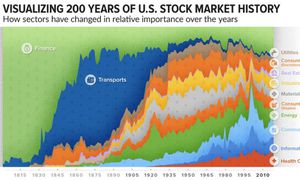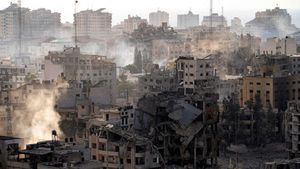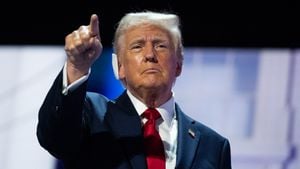Tokyo — The recipient of this year's Nobel Peace Prize is the fast-dwindling group of atomic bomb survivors, known as hibakusha, who are working tirelessly to convey the harrowing stories of the bombings they lived through nearly eight decades ago.
This year, the Nobel Peace Prize was bestowed upon Nihon Hidankyo, the Japan Confederation of A- and H-Bomb Sufferers Organizations, recognizing their decades of activism against nuclear weapons. Their tireless efforts have been central to keeping the narrative of the Hiroshima and Nagasaki bombings alive, even as their numbers dwindle. The current average age of hibakusha is around 85.6, creating urgency as survivors express concern over the younger generations' fading awareness of the atomic bomb's horrors.
Terumi Tanaka, 91, who survived the Nagasaki bombing at just 13 years old, has been vocal about the importance of initiating conversations about nuclear weapon disarmament. He articulated his hope for the Nobel Prize to serve as not just recognition of the past but as a catalyst for raising awareness among the public about the necessity of achieving a world free from nuclear weapons. With the nuclear threat rising globally, Tanaka expressed his frustration, stating, "Now we face the crisis in which nuclear weapons may be actually used and they are not even going away." He stressed the need to properly educate younger generations about atomic bomb effects and to inspire collective action.
At the press conference, Tanaka highlighted the significance of the hibakusha’s message. He remarked, “We’ve led the activism because we were atomic bombing victims, but I must say all of you are the future hibakusha candidates. So you should fully understand what it means to be hibakusha and work together.” Such statements reveal not just the burden of past experiences but also the hope pinned on youth to grasp the weight of those stories and advocate for change.
Despite their frail state, many hibakusha retain the spirit to continue their grassroots campaigns. These individuals recount their horrific experiences from the bombings, facing not just the physical and emotional scars but also enduring societal stigmas and health worries stemming from long-lasting radiation exposure. They do so with the resolute commitment of preventing such tragedy from ever happening again. Yet, the dwindling membership of prefectorial hibakusha groups—which has decreased from 47 to 36—speaks volumes about the urgency of their mission.
Within the complex dynamics of contemporary Japan, the political discourse surrounding nuclear policies adds another layer of challenge. Japan’s new Prime Minister Shigeru Ishiba has stipulated the necessity of maintaining nuclear deterrents for national security. While he acknowledged the need to share the history of nuclear tragedy, he framed deterrence as complementary to the aspiration of achieving nuclear disarmament. Such positioning has led Tanaka to reject this logic entirely, deeming it “out of the question” as he advocates for complete nuclear disarmament.
Members of Nihon Hidankyo are not merely lamenting their declining numbers; they are actively seeking to galvanize the youth. Jiro Hamasumi, who survived the Hiroshima bombing during his mother’s pregnancy, pointed out the group's efforts to draw younger supporters and second-generation hibakusha (children of survivors) to continue their activism. Their financial struggles, compounded by fewer active members, signify the challenges yet to be addressed.
Despite these hurdles, the Nobel committee notes signs of hope with the emergence of youth activism. Three high school students expressed their commitment to upholding the momentum of nuclear disarmament advocacy. “I had goose bumps when I heard the announcement,” said Wakana Tsukuda, referencing the Nobel Prize award announcement. She recognized the discouraging sentiments surrounding nuclear disarmament but affirmed her renewed dedication to the cause. “The Nobel Peace Prize made me renew my commitment to work toward abolishing nuclear weapons.”
Another student, Natsuki Kai, echoed this sentiment, asserting, “I will keep up my effort so we can believe nuclear disarmament is not just a dream, but reality.” Engagements like these reflect not only the awareness of atomic bomb history but also the resolve to combat the prevailing nuclear threat.
Further illustrating this connection, Yuka Ohara, 17, celebrated the recognition of Nihon Hidankyo, attributing her motivation to the legacy shared by her grandparents, also hibakusha from Nagasaki. She noted, “I want to learn more as I continue my activism,” highlighting the impending task to bridge the generational gap.
The effort to unite younger voices with hibakusha is amplified by networks such as the Japan Campaign to Abolish Nuclear Weapons. These campaigns connect younger generations with survivors to bolster advocacy for disarmament. The growing scope of initiatives promoting the documentation of survivors' experiences, including projects across Hiroshima, Nagasaki, and Tokyo, aims to weave these narratives deeply within the social fabric before it’s too late. This becomes not just storytelling but also fulfilling the responsibility to keep history alive.
Historically, the atomic bombings took unprecedented tolls on human life: Hiroshima witnessed the tragic loss of approximately 140,000 lives, followed by Nagasaki, where around 70,000 perished. The entire world felt the repercussions as Japan surrendered on August 15, 1945, marking the end of its bloody conflict across Asia.
Nihon Hidankyo emerged from the shadows of this tragedy eleven years post-war, catalyzed by the anti-nuclear sentiments surfacing from U.S. hydrogen bomb tests. Increasing demands for governmental support rose as victims grappled with their haunting experiences and health complications. Even today, housing 106,823 survivors seeking government medical assistance, the numbers starkly present the diminutive ratio of survivors compared to those registered decades ago, marking nearly one-quarter of the count during the 1980s.
Many survivors, especially those affected by the radioactive “black rain” outside designated zones, still struggle without necessary support. And as tales of their survival and activism resonate across generations, the symbolic weight of the Nobel Prize serves as both recognition and responsibility. It exemplifies not just the acknowledgment of past tragedies but also the assertion of resilience, urging current and future leaders to prioritize nuclear disarmament and to genuinely comprehend the humanitarian impact represented by hibakusha.
So, as Nihon Hidankyo stands as the Nobel laureate, the voices of hibakusha call out, demanding clarity, attention, and action from the global community, not just to honor their suffering but to prevent such tragedies from repeating.



